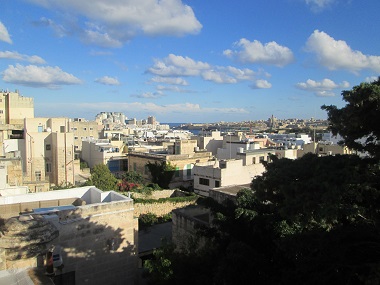
The view from Bishop’s House, where we stayed, over Sliema and Valletta and the harbour between them.
This is the third of four vignettes from the 40th anniversary trip Margaret and I took to Armenia, Georgia, Malta and England earlier this fall.
We Canadians like to think of our nation as multicultural. A visit to Malta puts that kind of thinking in perspective.
When you look at a map of the Mediterranean, the archipelago of Malta shows up as a series of tiny dots south of Sicily, just off the coast of Africa (only three of the islands are inhabited – Malta, Gozo and Comino).
The seesaw battles for domination of the region by various European and Muslim powers have shaped Malta – and sometimes placed it right in the eye of the storm.
During our 10 days in Malta, we were fortunate enough to stay with friends who introduced us to the island and its culture, especially related to the legacy of the Knights of St. John and the more recent British rule.
Malta’s rich history
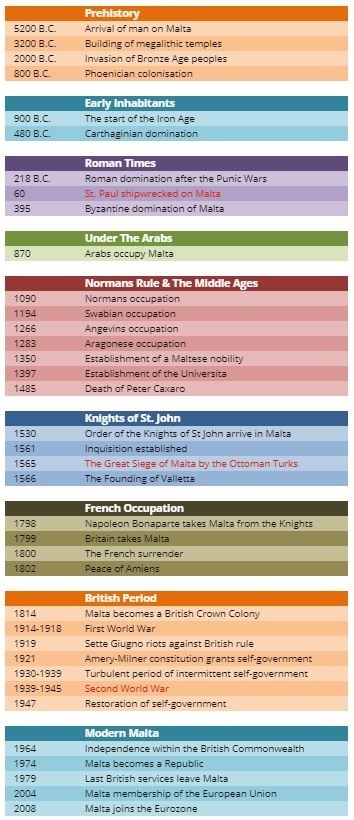 The accompanying timeline from the Malta Tourism Authority gives a sense of how varied Malta’s history has been.
The accompanying timeline from the Malta Tourism Authority gives a sense of how varied Malta’s history has been.
Here are some things that stood out for us:
- Several Megalithic temples are among the most ancient in the world. Ggantija on Gozo and the Hypogeum on Malta (an underground cavity with halls, chambers and passages hewn out of the rock) – which date back to at least 3,500 BC – are UNESCO World Heritage sites.
- The Bible features Malta; the apostle Paul was shipwrecked on the island around 60 AD (Acts 27:27 – 28:5), while it was under the control of Rome. These verses are carved in their entirety on a monument in Mdina, and are a testament to the generous hospitality of the Maltese people.
- Arabs occupied the island for a couple of hundred years, before being conquered by the Norman ruler Roger I of Sicily. The culture left a significant mark on the Maltese language; even today there are many towns bearing names such as Mdina and Rabat.
- The islands were given to the Order of the Knights of St. John in 1530 by King Charles, the Holy Roman Emperor (and nephew to the Spanish first wife of Henry VIII). In turn, they gave him a Maltese falcon each year as rent.
- The Order was expelled when France invaded the islands in 1798. When they began stripping the churches, the Maltese rebelled, the French were expelled in 1800 and Malta soon fell under British control.
- Malta gained independence in 1964 and became a republic in 1974. Since 2004 it has been a member state of the European Union.
Old friends and guides

Enjoying a meal with old friends in Malta. From left: Brenda Bailey, Margaret and me, Elaine Ferguson, Mark Griffiths and John Bailey.
Our time in Malta was particularly special because we shared it with our old friends John and Brenda Bailey and Mark Griffiths and Elaine Ferguson. John, Mark and I go back to grade eight at Lord Byng.
John’s serving as an Anglican priest in Sliema and his membership in the Sovereign Order of St. John of Jerusalem, Knight Hospitaller contributed immeasurably to our understanding and appreciation of Maltese history.
John and Brenda hosted us at Bishop’s House in Sliema, which faces Valletta, the capital of Malta, across Marsamxett Harbour.
John – a recently retired priest from the Anglican Diocese of New Westminster (basically Metro Vancouver) – was interim priest in charge at Holy Trinity Anglican Church from mid-September to early November.
Holy Trinity / Bishop’s House

The Rev. Dr. John Bailey preaching at Holy Trinity Anglican Church, Sliema.
Holy Trinity, one of three Anglican churches in Malta, is part of the Church of England. The church was begun in 1866 under the direction of Walter Trower, Bishop of Gibraltar. When the building was consecrated in 1867, the Malta Observer quoted the bishop as saying:
The new church had been built in Early English style for the happy purpose of reminding the brethren of the village churches at home which always inspired one with good and pure thoughts.
A 2016 entry from Trip Advisor – which has numerous positive entries about the church – described it in this way:
Built in 1866 mainly for the British service men and women who were based in and around Sliema area. [St. Paul’s Pro-Cathedral in Valletta catered to a more socially elevated element of the British colony.] The church continues to thrive today with the congregation mainly made up of ex-pats living in the Sliema area, plus tourists who come to visit on a regular basis. It is an Anglican church but everyone is made welcome.
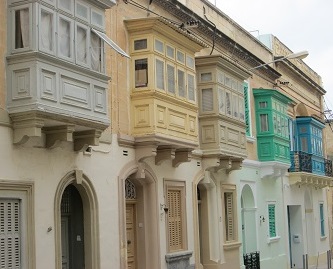
Across the street from Bishop’s House.
Next to the church is Bishop’s House, built in 1855 and used as the chaplain’s residence. In between the two buildings is a handy little second-hand bookshop called Books & Bits with all donations going to help with the upkeep of the church and gardens.
The Anglican churches in Malta remain part of the diocese of Gibraltar.
There was plenty of room for all of us at Bishop’s House, which featured four bedrooms, spacious and high-ceilinged living, study and dining rooms, along with a large garden in the back. Parishioners from Holy Trinity had tea in the Bishop’s House garden after services.
Probably the most appealing feature of the house, though, was the large flat roof, which commanded a tremendous view toward Valletta.
Sovereign Order of St. John
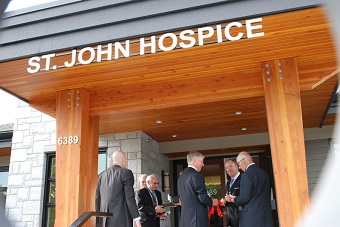
St. John Hospice opened five years ago at UBC.
John Bailey was in Malta to fill in as a priest at the local Anglican church. But he had another reason for being interested in Malta as well.
A couple of years ago, he was welcomed into the Vancouver Commandery of the Sovereign Order of St. John of Jerusalem, Knights Hospitaller (SOSJ).
(There are now, if I’m not mistaken, several groups of the Sovereign Orders of St. John operating in various locations, though all claim similar origins. Go here for a fuller account of the complex history.)
The group’s main focus, locally, is the support of palliative care in BC. John is a member of the Almoner Committee, which supports a wide range of projects, including St. John Hospice and Purdy Pavilion at UBC, Bloom Group Cottage Hospice in Vancouver and Peace Arch Hospice in White Rock.
As well, “SOSJ is in partnership with Bloom Group to build a new hospice in the Downtown Eastside serving Vancouver’s most marginalized citizens. The St John Hospice at May’s Place will be a 10,000 square-foot facility occupying the fourth floor of a new building.”
Of course, the order has a storied history, as it describes briefly:
Our modern Sovereign Order of St. John is a 900-year-old Sovereign Order steeped in a history of service to the Lord’s poor and sick. Our members are individuals who have demonstrated an organizational and personal commitment to the betterment of society and who work towards the goals of the organization.
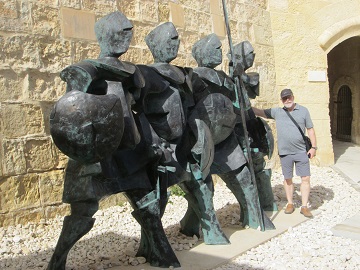
By the entrance to the National War Museum in Fort St. Elmo.
They add:
Our rich heritage of defending the Christian religion and serving humanity goes back over 900 years to the time of the First Crusade.
When the Crusaders stormed the gates of Jerusalem in 1099, they found a hospice, later dedicated to St. John the Baptist, which had been established for the purpose of helping sick and weary people who had made pilgrimages to the Holy Land, but it treated Christian and Muslim alike. . .
As support for the Crusades waned, so did support for the order, which lost its last foothold in Acre in 1291. After a short time on Cyprus, they were based on Rhodes for more than 200 years. Again forced out, this time by forces under the control of Suleiman the Magnificent, they were homeless for several years until the Holy Roman Emperor, Charles V, bestowed the island of Malta on the order in 1530:
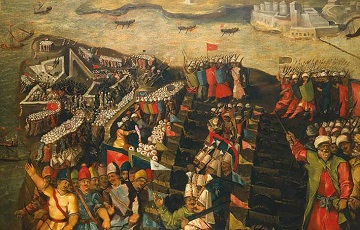
The Ottomans attacking Fort St. Elmo during the Great Siege of 1565.
As they had done on Rhodes, the Knights built a great hospital. They strongly fortified the island and greatly expanded their navy. Their wealth expanded rapidly, and the Sovereign Order became the owner of vast properties throughout the Christian world. Their skills and knowledge as bankers for the world became renowned.
Again on Malta, however, the Sovereign Order faced a determined attack by the forces of Islam, this time with a much superior force of 40,000 men. The Knights, about 650 strong, fought bravely, and, although they sustained great losses, they eventually forced the enemy to withdraw. This battle [in 1565] went down in history as The Great Siege of Malta, and it halted further movement of Islam into the Western World.
The Knights remained on Malta until Napoleon seized the Islands, and the wealth of the Sovereign Order, on his way to Egypt in 1798.
The other great battle
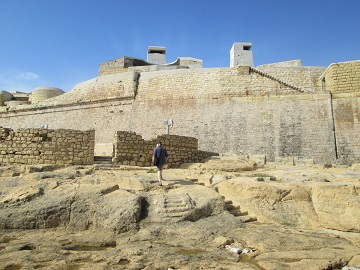
The National War Museum is housed in Fort St. Elmo; the view from the waterfront.
We missed Victory Day, which is held every year on September 8. It celebrates two great victories – the Great Siege of Malta and the British and Allied defence of Malta from the combined German and Italian air forces during World War Two.
Heritage Malta said this about Victory Day celebrations at Fort St. Angelo:
Victory Day happens to be very significant for the Maltese Islands and its people since it marks a number of momentous events, including the victorious end of two terrible sieges.
On 8th September 1565, the Ottoman forces gave up their attempt to take over the Islands after three months of relentless fighting and heavy losses.
The same day in 1943 saw the end of the brutal bombardments of the Islands after the announcement of the armistice of the Fascist regime in Italy. Incidentally, the day coincides also with the celebration of the birth of the Virgin Mary.
What we did see was the impressive National War Museum, which chronicled both great sieges. Housed in Fort St. Elmo, on the point below central Valletta, the fort – along with Fort St. Angelo across the Grand Harbour – is a stirring visual reminder of Malta’s unique history. Malta and Gozo are vibrant cultures looking to the future, but they are also veritable treasure houses full of memories – and lessons – for all comers.

Thanks again, Flyn, for a great article – very informative and interesting. And a special thanks for preparing and distributing this weekly newsletter. Much appreciated.